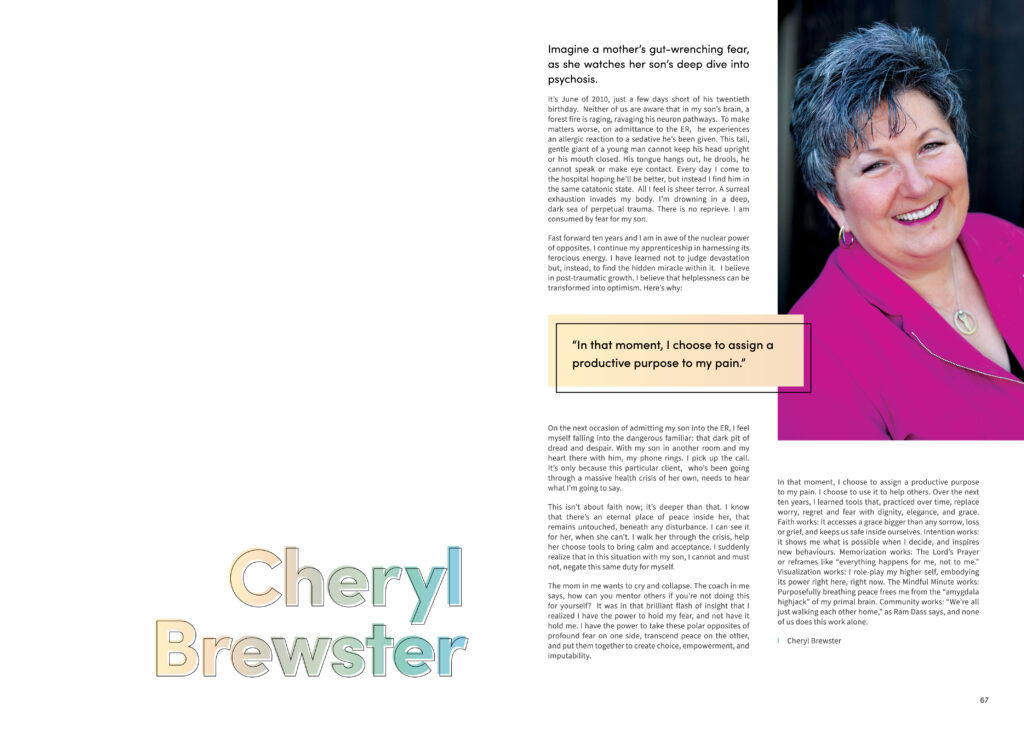“In that moment, I choose to assign a productive purpose to my pain.”
Imagine a mother’s gut-wrenching fear, as she watches her son’s deep dive into psychosis.
It’s June of 2010, just a few days short of his twentieth birthday. Neither of us are aware that in my son’s brain, a forest fire is raging, ravaging his neuron pathways. To make matters worse, on admittance to the ER, he experiences an allergic reaction to a sedative he’s been given. This tall, gentle giant of a young man cannot keep his head upright or his mouth closed. His tongue hangs out, he drools, he cannot speak or make eye contact. Every day I come to the hospital hoping he’ll be better, but instead I find him in the same catatonic state. All I feel is sheer terror. A surreal exhaustion invades my body. I’m drowning in a deep, dark sea of perpetual trauma. There is no reprieve. I am consumed by fear for my son.
Fast forward ten years and I am in awe of the nuclear power of opposites. I continue my apprenticeship in harnessing its ferocious energy. I have learned not to judge devastation but, instead, to find the hidden miracle within it. I believe in post-traumatic growth. I believe that helplessness can be transformed into optimism. Here’s why:
On the next occasion of admitting my son into the ER, I feel myself falling into the dangerous familiar: that dark pit of dread and despair. With my son in another room and my heart there with him, my phone rings. I pick up the call. It’s only because this particular client, who’s been going through a massive health crisis of her own, needs to hear what I’m going to say.
This isn’t about faith now; it’s deeper than that. I know that there’s an eternal place of peace inside her, that remains untouched, beneath any disturbance. I can see it for her, when she can’t. I walk her through the crisis, help her choose tools to bring calm and acceptance. I suddenly realize that in this situation with my son, I cannot and must not, negate this same duty for myself.
The mom in me wants to cry and collapse. The coach in me says, how can you mentor others if you’re not doing this for yourself? It was in that brilliant flash of insight that I realized I have the power to hold my fear, and not have it hold me. I have the power to take these polar opposites of profound fear on one side, transcend peace on the other, and put them together to create choice, empowerment, and imputability.
In that moment, I choose to assign a productive purpose to my pain. I choose to use it to help others. Over the next ten years, I learned tools that, practiced over time, replace worry, regret and fear with dignity, elegance, and grace. Faith works: It accesses a grace bigger than any sorrow, loss or grief, and keeps us safe inside ourselves. Intention works: it shows me what is possible when I decide, and inspires new behaviours. Memorization works: The Lord’s Prayer or reframes like “everything happens for me, not to me.” Visualization works: I role-play my higher self, embodying its power right here, right now. The Mindful Minute works: Purposefully breathing peace frees me from the “amygdala highjack” of my primal brain. Community works: “We’re all just walking each other home,” as Ram Dass says, and none of us does this work alone.

Are you ready to share your story of RESILIENCE? You can do that HERE.
